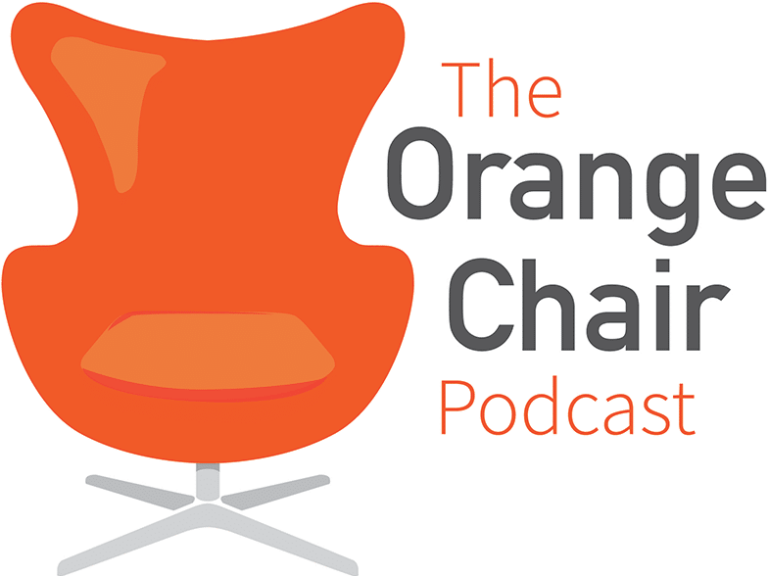This website uses cookies so that we can provide you with the best user experience possible. Cookie information is stored in your browser and performs functions such as recognising you when you return to our website and helping our team to understand which sections of the website you find most interesting and useful.
Listen now on your favorite streaming service!
presented by KeyMark


Summary
The following is a transcription from The Orange Chair Podcast. Today, we’ll begin a two-part series that covers a variety of topics about leadership strategies and technology trends within organizations. We’ll be interviewing Clemson University’s Director of Leadership Development and Corporate Relations, Gail DePriest and KeyMark’s CSO, John Harrison.
To listen to the full episode, or any other episode, you may do so by selecting your preferred podcast listening method on The Orange Chair Podcast page.
Transcription
Introduction
Alex Frazier: Welcome to The Orange Chair Podcast. We are doing something different because today’s episode is part one of a two part series.
Over the next two episodes, we will be learning about leadership and technology and how the two can work together within an organization. So sit back and let’s jump on into this episode.
Alex Frazier (0:38s): Hey, everybody. Welcome to The Orange Chair Podcast. Today in the orange chairs, we have special guests, Gail DePriest and John Harrison. We’re talking about all things technology and leadership and why those two things go hand-in-hand.
It’s gonna be a great episode, but to kick things off, I’ll go ahead and let our guests introduce themselves to you.
So Gail, who are you? What are you?
Gail DePriest (1m 11s): Thank you, Alex. I work at Clemson University and specifically in the MBA program, which is located in downtown Greenville, SC.
I consider myself to be somewhat of an entrepreneur in residence there because I teach the innovation and creativity class for our MBA and entrepreneurship.
And I love the students. I love them coming in the door and wanting to be better leaders and be better as entrepreneurs or intrepreneurs. So that’s what I do.
I also run the Business of Innovation Podcast. So I’m looking to learn a lot from you today.
Alex Frazier (1m 47s): Well, we’re excited to have you on. John, what about you? Tell us about yourself.
John Harrison (1m 52s): All right. Thank you, Alex. I’m the VP of Sales here at KeyMark and get to see you every day when I walk in the door and really my job is to serve our sales folks and help them be successful. And, and really, I think we’re going to potentially talk about this later, but really help them serve our customers well and help them get to the goals that they’ve agreed to accomplish with us.
Alex Frazier (2m 17s): I’d love to just hear some fun facts about you guys, just to kick off, to kick off our conversation, you know, maybe something that you like to do or something you know, fun about you.
Gail DePriest (2m 31s): Well, I guess I can get first, I live right near Cleveland park near Falls Park. I spent a lot of my free time in the Falls Park, but just because I think everybody turns into big kid when they get on a bicycle and they get into the park. A lot of times where you have great ideas and you really can get into that mode that just relaxes you. So, yeah, I ride a bike and I’m like, 10 years old when I do.
John Harrison (3m 0s): I’m trying to think of a good fun fact. I have five dogs. If people follow my wife on Facebook, they know that probably the most interesting animal thing is that my wife and I rescued a squirrel in 2009 and a story about her and my wife was released in 2017 and it’s been viewed on Facebook 76 million times. And I wrote a children’s book about it. So we’ve had fun with that.
The Business of Innovation Pawdcast
Alex Frazier (3m 38s): I’d love to hear about the business of innovation podcast. So what is that podcast? What do you guys talk about on there at Clemson MBA?
Gail DePriest (3m 46s): We really wanted to start capturing stories of individuals that were out in the world doing innovative things. And we just started having those conversations with people that we wanted to hear more about their story.
It has been fascinating. I think we’ve, we just interviewed the director of the symphony. I’m sorry, the director of the peace center and all that’s happened in 25 years at the Peace Center.
Now they’re $26 million organization, which is phenomenal.
We just interviewed the CEO of KeyMark and heard his amazing backstory.
I just interviewed the CEO of Michelin North America, who is all about interpersonal and empowering his employees much like your CEO.
We have had a lot of fun bringing those stories in and sending them out into the world through our podcast. So I just feel honored to get to sit in that seat and, and hear the stories.
How Technology has Evolved in Enhancing Leaders
Alex Frazier (4m 48s): Yeah. That’s incredible. I bet you do get to hear a lot of really interesting things. How do you see advantages in technology enhancing how business leaders are leading and maybe how has that changed over the years?
John Harrison (5m 2s): That’s a great question, Alex, and I’ll take a shot at that and I’m sure we might have some discussion around this, but I’ll age myself to start with.
In 1995, I started in sales with Datastream and I was a school teacher prior to that. We had a DOS-based CRM system. We were selling windows systems and that was the new thing. So the software we sold was newer technology than some of the stuff we’re using.
So really being in technology all these years, it has been interesting to see how it impacts me as a user, but also selling technology and how it helps businesses and whatever they might be doing in the sector that I may be selling software in. Of course with us and enterprise content management, we’ve come a long way from scan store retrieve to now it’s really just capturing data in any possible way, and then presenting it in a certain way that that helps businesses make decisions.
John Harrison (6m 4s): What’s interesting is there are companies out there that are embracing it from the get go and understanding that technology can help you do less or do more with less. So I may be able to kick off my business and reach more people through the use of technology and grow the way I want to grow versus the old way of doing it without technology, where it’s very difficult to reach as many people or reach the audience that you’re trying to. There are organizations that try to get by without doing that.
I think we’re getting to a point, at least in the businesses we work with, where that can be fatal to an organization. If you choose not to utilize technology the way your competitors are, or to help you become a more efficient organization, the potential is that you could end up going out of business. So it’s very interesting. And of course it places a lot of importance on what we do and how we deliver and the solutions that we’re providing our customers.
Will Technology Lead People or Will People Lead Technology?
Gail DePriest (7m 18s): I would just kind of jump in, in a couple of areas. First of all, I’m so glad to see that KeyMark is at the helm of delivering a lot of solutions in the technology arena.
My concerns about technology are around is technology going to lead people are people gonna lead technology? So it’s so good to know a company like yours helps to find these kinds of solutions. The other area that I hope we continue to look at is will the lawn be blurred between, you know, home life and work life will look, continue to blur because of the technology.
So having said that, I haven’t heard anyone say DOS and MSDOS in probably about 20 years! I’m glad you brought that up because when I was in sales and marketing pharmaceutical and healthcare in the late eighties and early nineties, it was Rolodex cards. Then it was maybe a contact management system, but that, I certainly appreciate that technology is huge for geographically distributed, you know, sales people and their connectivity to customers and to colleagues.
I just believe there’s so much more available now. I know you’re going to ask a question about how we’re using it on the educational front, but I certainly see the advantages and certainly see the disadvantages for companies that aren’t willing to, to look and stay ahead of the curve with technology.
Word of Caution: Tech is a Tool and Can’t Replace Leadership Roles
John Harrison (8m 47s): Right. Well, I’m glad you, you, you made me think of a another point and I think this is something that we have to be careful about.
Technology can be a great thing, but I think all of us could point to issues in society as parents, teachers, and running a business where technology, if not used correctly, can be a detriment to what you’re trying to do. It’s one of those things where we can’t look to technology to replace the things that are important and dealing with our employees and dealing with our customers, a relationship of listening and trust cannot be created through technology.
I’m not going to build that through an email relationship with somebody or expecting someone to talk to my automated system and get that personal experience. So I think, and that was one of the things thinking about what we were going to discuss today. I wrote down as a note is, you know, it’s never going to replace those key things that we have to do in a sales process that involve human emotion and building a relationship and, and really understanding and making a decision based on where you are in a, in a sales process or, or, or whether it’s, you know, dealing with one of your employees from a leadership standpoint, you know, it’s never going to replace that.
I think it’s important to realize that and, and apply it where it really makes a difference to help you be more successful, but at the same time, make sure that you keep the human element that’s important for all of us.
Gail DePriest (10m 28s): Hearing you say that, John, I guess I’m curious to know in your work with KeyMark, do you feel like that’s something that stays in the forefront of your philosophy in dealing with customers as you design solutions for them? That you’re always thinking about what’s going to happen with the people aspect once the software or the technology comes in?
Seeing Tech’s Communication Impact Across Different Generations
John Harrison (10m 47s): Absolutely. And we talk about it a lot and I do think it’s a, it’s also a generational thing. I think that what I found is that younger generations who are used to communicating with technology and have been doing so their entire life, their perspective is a little different on how that works because it’s just a natural way of communicating.
So texting or email might be their preferred method of communicating.
But if they’re communicating with someone that’s an older generation who wants that human touch. From a sales perspective or even project management, any interaction with a customer, they’re going to view that differently.
So back to some of the things we’ve talked about with you, I think understanding who you’re dealing with and how they see the world from a technology perspective can help you communicate with them the right way. And that may not fit into your way of doing things.
But that’s one of the things we stress here that you can’t build a relationship through a computer screen. And the other thing that we’ve talked about, and this is one of my own personal rule, and I learned learn the hard way, but you’re not going to solve a problem over email. And instead of typing up that long email, that can be misread, go talk to the person face to face. So you can see tone and you can, or you can hear tone and you can see in their face that the goal is really just to address the problem.
That’s something that we talk about a lot with our sales team, and I think it’s been very positive, but this company in, in general has a culture of, of talking with each other, having fun together. And so that’s one of the things I love about being here.
Tech’s Impact on Higher Education
Alex Frazier (12m 42s): Yeah, no, that’s great discussion. How does technology change what you guys do in the education space?
Because I imagine it would be similar to what you’re talking about with each year as a new wave of students come in, that must change.
Gail DePriest (13m 4s): Well, it’s interesting because at the Clemson MBA, we really thought long and hard before we created an online program. We saw it happening all across the country for MBA programs. But what’s different about Clemson is so many people engage at Clemson for the network, relationships and the kind of benefits that come from having that as part of your degree.
So ultimately just last year, we rolled out our fully online MBA in addition to our MBA for Entrepreneurship and our MBA for Statistics and Analytics, and then our Corporate MBA. So we have like four flavors, but the fully online MBA is actually one.
We don’t think there’s another one exactly like it, but you can actually come and sit in the classroom with a professor or you can consume it completely online somewhere else.
That way, if you truly want to be online, you’re seeing into a classroom, you can come in with questions, you can hear people in the room, but it’s, so it’s a bit of a blended experience.
That way we’re offering the online, but we’re also acknowledging that people have different learning styles. Some people are visual, kinesthetic, auditory, and, and so forth. We know that the way they consume learning is really different. So we wanted to, to honor that as well.
John Harrison (14m 39s): I can attest to that as a student in the MBA program, like the relationship I have with my cohort, has been incredible. In fact, many times we discussed the investment in this MBA is worth it, even if we had no classes and we just got to know those folks over the weekends we spent together and it it’s been fantastic. So, yeah.
Gail DePriest (15m 5s): And what John is referring to is our MBA for entrepreneurship is set up as a weekend program. So you come in Friday, Saturday, Sunday, two weekends, a semester over a period of a couple of years.
We have people flying in from Germany, from California because they’re just coming in for a long weekend. We put them up in a nice hotel nearby and they go through the program as a cohort. We know they’re going to lean on each other, they’re going to depend on each other. They’re going to learn so much from each other and they’re going to make good business relationships and probably do business together, or probably create a business together.
We’ve seen that happen too. So we feel like the relational part of learning is so important. And then there’s the technical part that’s taught in between these weekend sessions where there’s a lot of online exchange and, and assignments and so forth. So certainly the technology is there, but it really, I think that program in particular speaks to the connectivity that happens between students.
Successful Technology Implementation in Business
Alex Frazier (16m 9s): So just to shift gears a, a little bit, you know, how do you see a successful implementation of technology in a business space?
John Harrison (16m 18s): That’s another good question. And I think there’s a lot of different answers to that. For me, it would really be hard to try to break that down into one statement. But I think success is when your customers have achieved the expectations that they had going into an implementation, and they can point to an ROI or a value that we agreed we would achieve with that project.
That never ends. I think if we have a three month project and we get to the end, we want to start monitoring how that system or solution is working for them. Is it giving them the payback and the benefit that we talked about early on?
Moving forward, we always want to think about how can we expand and do more and provide more value.
Then I think for us, and we talk about this as a sales team is if, if we have a new customer that is implementing our solution as a point system, they want it to do this particular use case.
You know, our goal is to do that successfully, but at some point in the future, we want their CIO, their CFO, their CEO, to see KeyMark and the solutions set that we provide as a strategic solution for their organization. Because there’s a lot, if you talk to our customers and you asked them that question, they could list a hundred different systems they use, but they’re probably not going to tell you more than two or three systems that are truly strategic to the success of the organization.
That’s where we want to be. We, and to do that, you obviously have to be delivering value to get to that point.
Successful Project Implementations in Higher Ed
Gail DePriest (18m 10s): I guess to answer that from the space in which I sit, I know that we work diligently and I certainly wasn’t the, at the head of this, but we worked diligently to make sure everyone was completely trained as the implementation occurred of our new online program.
There was special training for instructors. They were also given assistant students to be with technology assistants, to be with them in the classroom and to make sure things were working.
Have we had a few glitches? Absolutely. You know, and that’s just part of, you know, listening to students, listening to feedback and listening to professors to make sure we can smooth those out, you know, pull back and regroup.
But overall, you know, we kept, we knew that our students, especially those that travel a great deal, really wanted an online program and we were determined to meet that need.
So just continuing to go back to the drawing board and to, to work with provider providers that we felt comfortable with.
Why Some Business Leaders Aren’t Quick to Adopt New Technology
Alex Frazier (19m 13s): To elaborate on that a little bit. What do you guys see as hurdles for why business leaders may or may not be utilizing emerging technologies, new advances, those types of things within their businesses?
John Harrison (19m 29s): I’m going to defer to Gail.
Gail DePriest (19m 30s): You are deferring? You know, that’s a really good question. I would imagine that sometimes there’s a hesitation to bring in another layer of technology.
Sometimes when people have gotten comfortable with what they’re currently using, what they’re currently tapping into. That’s what I would imagine would hold businesses back.
I think to John’s earlier point it’s, it really is critical to be looking at the idea of what else is out there and not getting behind on technology.
Now, having said that, I really do want to say that when you have employees who are geographically dispersed and they’re working in their homes, they’re working.
Keeping People Connected, Especially With The Rise of Remote Work
Gail DePriest: One of the things concerns that I have is, you know, some of the new neuroscience studies are telling us that we are wired for service and we’re wired to collaborate.
That’s when our brain lights up in a particular way. But if we become too isolated, sometimes it can actually affect our ability to be, it’s not as good for us.
It’s not as good for us in terms of our staying positive and staying engaged.
So for me, the concern I would think would be that of isolation. Trying to avoid people, feeling isolated out there when they do have the benefit of working from home, but keeping them connected to the team. John, you work with salespeople all the time. So I’m sure you’ve looked at that issue.
John Harrison (21m 15s): Absolutely. To the point of people that are working out in the field, or they work from their home because they live in their territory, it is, I’ve been both, I’ve been on both sides of that. While we get together and complain about how long we drive every day, being here on this office, there’s a huge benefit to that.
My job is to make sure we address that issue for our sales people that live out in the field to make sure that they’re included, especially when we get together as a team, but that we’re talking often.
We’re trying to take out the fact that they can’t just walk down the hall and ask a question of somebody that we, that we make sure we’re responsive to them. Like we would be if they were in the office.
Empowering Employees to Think and Create
John Harrison: I think to back to your question about technology and what creates a success or failure, or what are the roadblocks to successfully using it?
I really think it goes back to culture and leadership. What I mean by that is there are organizations that their culture is a culture of innovation and of creativity, where every employee is encouraged to be creative, to think about how they can make the business better, regardless of the level they are in the organization.
I think that people would be surprised how many companies do not operate that way. That on the surface appear successful, but they’re not even close to their full potential because of a culture that doesn’t promote creativity and does not ask for all of their employees to think of new ways and speak up about ways that they can move the company forward.
In those organizations where it’s, you know, “I just want to keep the status quo” or “I don’t want to stir the pot. If I try to get creative, I might do that.”
What you find is no one is ever coming forward with ways to utilize technology or ways to maybe take something you’ve already implemented and make it better. That’s another thing I love about this organization is we want everyone’s opinion on how we can get better.
You might share your opinion a hundred times before someone says, “yeah, we’re going to do that.” But once you get there, it can really help the company.
So I think that’s, that’s very important so that people, you know, to, to promote that so that people feel like, “hey, I can bring an opportunity to the table.”
I can look for ways to incorporate technology into what we do to make us better, no matter who I am, what title I have, what level I am in the company.
Technology Has Changed Long Term Planning
John Harrison: Those are the companies that are going to thrive, moving forward with technology, taking over the speed of change. Now we used to make five year plans and ten year plans.
Now it’s one year and two year plans and six months, it’s where we’re going to be in two years. You don’t know! So you have to really capture the moment. If you’re not doing that and using technology to do that, you’re going to fall behind very quickly.
Alex Frazier (25m 1s): Well, that’s all that we have for you guys today. Thank you so much for listening to this podcast. The Orange Chair Podcast is brought to you by KeyMark.
If you liked this podcast, please leave us a rating like and subscribe to our podcast channel, wherever you guys are listening to podcasts, and you can even follow us on Instagram and Facebook. And we would love to hear from you.
This podcast is produced by Greg Aiken, Clay Tuten and me, your host, Alex Frazier. Until next time, bye guys.
Continue to Leadership and Technology Podcast, Part 2!







